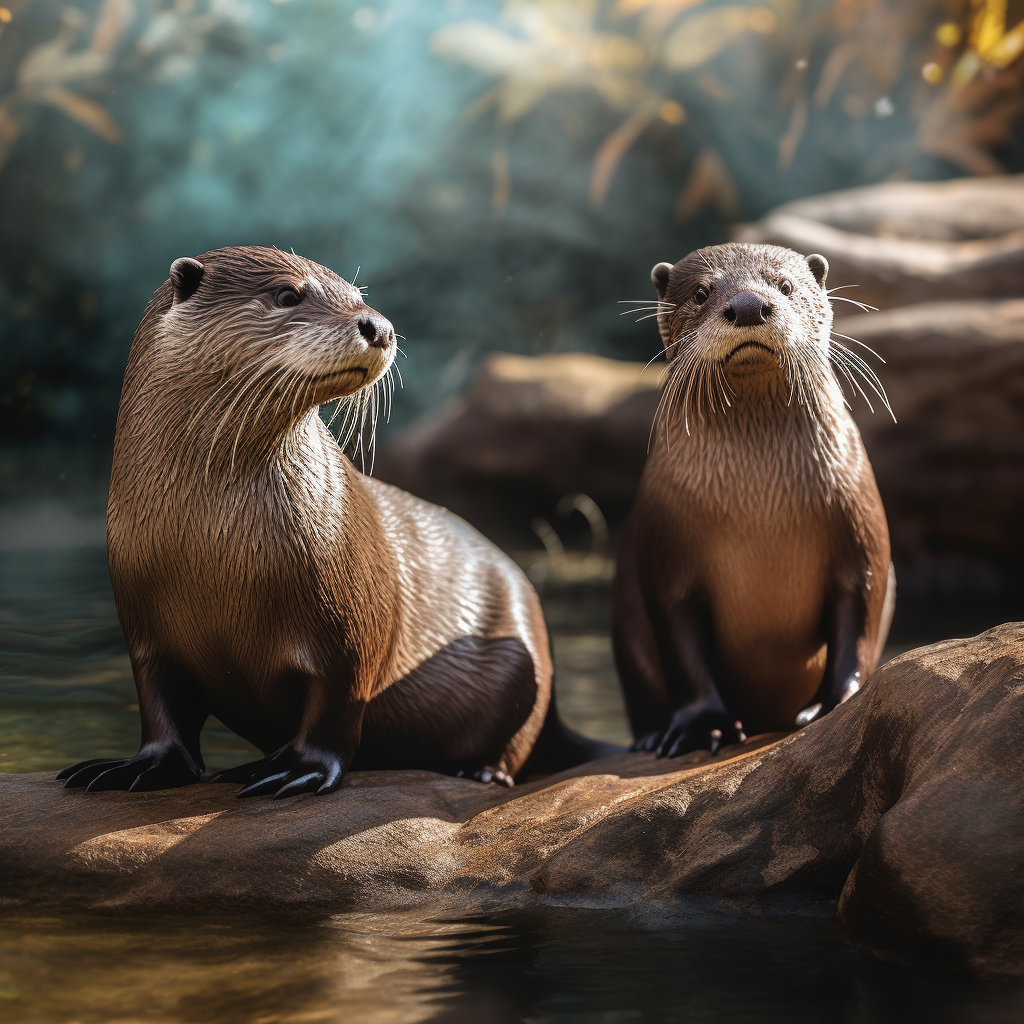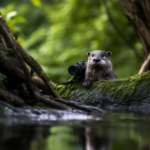River otters are fascinating creatures that are known for their playful nature and excellent swimming skills. While they are primarily aquatic animals, spending most of their time in rivers, lakes, and wetlands, they are also capable of venturing onto land. In this article, we will explore the behavior and adaptations of river otters when they are on land, as well as the reasons why they may choose to leave the water. From their physical characteristics to their hunting techniques, we will delve into the world of river otters on land and discover the unique aspects of their lives outside of the water. So, let’s dive in and learn more about these charismatic mammals and their terrestrial adventures.
Key Takeaways
- River otters are highly adaptable and can spend a significant amount of time on land.
- They have a streamlined body and webbed feet, which allow them to move efficiently both in water and on land.
- River otters primarily come on land for activities such as resting, grooming, and giving birth.
- They are excellent swimmers and can travel long distances in search of food or suitable habitats.
- Conservation efforts are crucial to protect river otters and their habitats, ensuring their survival in the wild.
Understanding River Otters: A Brief Overview

A. The Habitat of River Otters
River otters are fascinating creatures that inhabit various freshwater ecosystems across North America. They are highly adaptable and can be found in a wide range of habitats, including rivers, lakes, marshes, and even coastal areas. These semi-aquatic mammals have evolved to thrive in both aquatic and terrestrial environments, making them truly remarkable.
1. Rivers and Streams
River otters are particularly well-suited to life in rivers and streams. These waterways provide them with an abundant food supply, as well as a means of transportation. Otters are excellent swimmers, thanks to their streamlined bodies, webbed feet, and muscular tails. They can effortlessly glide through the water, diving and maneuvering with agility.
2. Lakes and Ponds
In addition to rivers and streams, river otters also inhabit lakes and ponds. These bodies of water offer a different set of challenges and opportunities for the otters. They are known to establish territories around lakes and ponds, where they can find ample food resources, such as fish, amphibians, and crustaceans. Otters are skilled hunters, capable of catching prey both in the water and on land.
3. Wetlands and Marshes
Wetlands and marshes are another favored habitat for river otters. These areas are rich in vegetation and provide a diverse array of food sources. Otters are known to consume not only fish but also small mammals, birds, and reptiles. Their diet is highly adaptable, allowing them to take advantage of the resources available in their environment.
B. Physical Characteristics: Adapted for Land and Water
River otters have a unique set of physical characteristics that enable them to thrive in both aquatic and terrestrial environments. These adaptations make them highly versatile and efficient predators.
1. Streamlined Body
The streamlined body of a river otter is perfectly suited for life in the water. Their long, slender shape reduces drag, allowing them to swim swiftly and effortlessly. This body shape, combined with their webbed feet and strong tail, enables them to navigate through the water with ease.
2. Dense Fur
One of the most remarkable adaptations of river otters is their dense fur. Their fur consists of two layers: a waterproof outer layer and a thick, insulating underlayer. This unique combination keeps the otters warm and dry, even in frigid water temperatures. The fur traps air close to their bodies, providing excellent insulation and buoyancy.
3. Agile Limbs
River otters have short, muscular limbs with webbed feet, which allow them to move both on land and in the water. On land, they can walk, run, and even slide on their bellies. In the water, their webbed feet act like paddles, propelling them forward with remarkable speed and precision.
4. Sharp Claws
To aid in their hunting and foraging activities, river otters have sharp, retractable claws. These claws are ideal for catching and gripping prey, as well as for climbing and digging. Otters are known to create burrows near the water’s edge, where they rest, raise their young, and seek shelter from predators.
In conclusion, river otters are fascinating creatures with unique adaptations that allow them to thrive in both aquatic and terrestrial environments. Their ability to navigate through water with ease, combined with their agile movements on land, makes them truly remarkable. Understanding their habitat and physical characteristics is crucial for appreciating the incredible versatility of these captivating mammals.
River Otters on Land: Debunking Myths

A. Can River Otters Live on Land?
River otters are primarily known for their playful and agile nature in the water, but they are also capable of living on land. While they are well-adapted to an aquatic lifestyle, river otters are equally comfortable on solid ground. Contrary to popular belief, they are not solely aquatic creatures. In fact, river otters spend a significant amount of time on land, engaging in various activities such as resting, grooming, and even giving birth to their young.
Although river otters are excellent swimmers, they possess adaptations that allow them to navigate the land as well. Their long, slender bodies, webbed feet, and strong claws enable them to move effortlessly on both land and water. These adaptations make them versatile and adaptable to different environments, allowing them to thrive in a range of habitats.
B. Do River Otters Sleep on Land?
Yes, river otters do sleep on land. While they may build burrows near water bodies for shelter, they often choose to rest on land during their sleeping hours. These burrows serve as safe havens where they can retreat when they feel threatened or during periods of extreme weather. However, it’s important to note that river otters are not exclusively dependent on burrows for sleep. They can also rest in other secluded areas, such as dense vegetation or fallen logs.
River otters are known to be crepuscular, meaning they are most active during dawn and dusk. During the day, they may find a cozy spot on land to take a nap or simply relax. It’s not uncommon to spot a river otter basking in the sun on a riverbank or a grassy patch. These moments of rest are crucial for their overall well-being and energy conservation.
C. Why Do Otters Come on Land?
River otters have several reasons for venturing onto land. One of the primary reasons is for social interaction. While they are generally solitary animals, river otters do come together in small groups, known as romps, for various activities. These gatherings often occur on land, providing an opportunity for otters to engage in play, grooming, and bonding with their fellow otters.
Additionally, river otters may come on land to search for food. While they primarily hunt in the water, they are opportunistic feeders and will take advantage of any food source available. This includes small mammals, birds, amphibians, and even insects that may be found on land. By exploring the terrestrial environment, river otters can expand their dietary options and increase their chances of finding a meal.
Another reason why otters come on land is for reproduction. Female otters will seek out a safe and secluded spot on land to give birth and raise their young. These areas, often located near water bodies, provide protection and easy access to food for the mother and her offspring. The land serves as a nursery for the young otters until they are old enough to venture into the water.
In conclusion, river otters are not limited to an aquatic existence. They are highly adaptable creatures that can thrive both in water and on land. Their ability to live and function on land is a testament to their remarkable adaptability and resilience in various environments. So, the next time you spot a river otter on land, remember that it’s just another part of their fascinating and diverse lifestyle.
The Land Activities of River Otters
River otters are fascinating creatures that spend a significant amount of their time in water. However, they are not solely aquatic animals. In fact, river otters are known to engage in various activities on land as well. Let’s explore what these playful creatures do when they venture onto solid ground.
A. What Do River Otters Do on Land?
When river otters find themselves on land, they exhibit a range of behaviors that are both intriguing and entertaining to observe. Here are some of the activities that river otters engage in when they leave the water:
-
Resting and Sunbathing: River otters often take advantage of sunny spots on land to rest and bask in the warmth of the sun. They may lie on their backs or sides, stretching out their bodies to soak up the rays.
-
Exploring and Marking Territory: River otters are highly territorial animals. On land, they explore their surroundings, leaving scent marks to establish their presence and communicate with other otters.
-
Playing and Socializing: Just like their behavior in the water, river otters love to play and socialize on land. They engage in playful wrestling matches, chase each other, and engage in other interactive behaviors that strengthen social bonds within their group.
-
Feeding: While river otters primarily hunt for food in the water, they also forage on land. They search for small mammals, birds, reptiles, amphibians, and even insects. Their diet on land may vary depending on the availability of prey in their habitat.
B. River Otter Walking on Land: An Unusual Sight
Although river otters are well-adapted to an aquatic lifestyle, they are also capable of walking on land. However, their movements on solid ground may appear a bit clumsy compared to their graceful swimming in the water. When walking on land, river otters use a bounding gait, pushing off with their hind legs and propelling themselves forward. Their webbed feet, which are ideal for swimming, are less efficient for walking, but they still manage to get around.
C. The Giant River Otter on Land: A Special Case
While the North American river otter is the most well-known species, there is another remarkable otter that deserves special mention – the giant river otter. This species, found in South America, is the largest otter in the world. Unlike its smaller relatives, the giant river otter spends a significant amount of time on land, often building dens in riverbanks. These dens serve as shelter and provide a safe place for the otters to rest, give birth, and raise their young.
In conclusion, river otters are not limited to their aquatic habitat. They exhibit a range of fascinating behaviors on land, including resting, exploring, playing, and foraging. While their movements on solid ground may not be as graceful as in water, they adapt and make the most of their time on land. Whether it’s the North American river otter or the giant river otter, these remarkable creatures continue to captivate us with their versatility and adaptability in both aquatic and terrestrial environments.
The Travelling Habits of River Otters

River otters are fascinating creatures known for their playful nature and graceful movements in the water. But have you ever wondered if these sleek swimmers also venture onto land for travel? In this section, we will explore the travelling habits of river otters, including whether they go on land, how far they can travel, and how different otter species compare in their land travel behaviors.
A. Do River Otters Go on Land for Travel?
While river otters are primarily adapted for life in the water, they do indeed spend time on land. However, their terrestrial excursions are usually limited to specific purposes, such as finding food, establishing territories, or seeking suitable den sites. River otters are excellent swimmers, but their ability to navigate on land is not as refined. Nonetheless, they are capable of traversing short distances on land when necessary.
When river otters venture onto land, they display a unique gait known as the “loping” or “bounding” gait. This gait involves pushing off with their hind legs and propelling themselves forward, similar to a galloping horse. While it may not be as efficient as their swimming abilities, it allows them to move relatively quickly on land.
B. How Far Will River Otters Travel on Land?
The distance river otters travel on land can vary depending on several factors, including the availability of resources, the presence of predators, and the overall landscape. On average, river otters tend to travel up to a few hundred meters on land. However, there have been instances where river otters have been observed travelling over a mile away from water bodies in search of food or suitable denning sites.
It’s important to note that river otters are highly adaptable creatures, and their ability to travel on land is just one of the many skills they possess. Their primary domain remains the water, where they are most agile and efficient.
C. Do Otters Travel on Land: Comparing Different Species
While river otters are the most well-known otter species, there are several other otter species that inhabit different parts of the world. Each species has its own unique characteristics and behaviors, including their land travel habits.
For example, the North American river otter, which we have been discussing, is known to travel on land when necessary. On the other hand, sea otters, which primarily inhabit coastal areas, rarely venture onto land. Sea otters are highly adapted for life in the water and spend the majority of their time swimming and foraging in the ocean.
Other otter species, such as the Eurasian otter and the giant otter, also exhibit varying degrees of terrestrial travel. These species may travel longer distances on land compared to the North American river otter, as their habitats often include larger expanses of land between water bodies.
In conclusion, while river otters are primarily aquatic creatures, they do travel on land for specific purposes. Their land travel abilities are limited compared to their swimming prowess, but they are still capable of navigating short distances on land. Different otter species may exhibit varying degrees of terrestrial travel, depending on their specific habitats and ecological requirements.
Conclusion
In conclusion, river otters are fascinating creatures that are equally at home on land as they are in water. Their ability to adapt to different environments and exhibit a wide range of behaviors makes them truly remarkable. Whether they are hunting for food, playing with their young, or simply basking in the sun, river otters on land are a joy to observe. These agile and social animals play an important role in maintaining the health of aquatic ecosystems, and their presence is a sign of a healthy and thriving environment. So, the next time you find yourself near a river or lake, keep an eye out for these playful and charismatic creatures. You might just catch a glimpse of a river otter in action!
Frequently Asked Questions
Can river otters live on land?
Yes, river otters can live on land and water. They are semi-aquatic mammals, meaning they spend time both in the water and on land. They typically live in dens on the riverbank, often in burrows dug by other animals.
Do river otters sleep on land?
Yes, river otters do sleep on land. They usually sleep in dens or burrows on the riverbank, which provide them with protection from predators and harsh weather conditions.
How far will river otters travel on land?
River otters can travel several miles on land to find new water sources or hunting grounds. Their territories can range from 1 to 30 square miles, depending on the availability of food and habitat.
What do river otters do on land?
On land, river otters engage in various activities such as grooming their fur to keep it waterproof, playing, resting, and sliding on their bellies for fun. They also hunt for food on land, especially when aquatic prey is scarce.
Why do otters come on land?
Otters come on land for a variety of reasons including to rest, groom, play, hunt for food, and to travel to new water sources. They also come on land to give birth and raise their young in dens or burrows.
Do otters travel on land?
Yes, otters do travel on land, especially when they need to move to new water sources or hunting grounds. They are quite capable on land and can run at speeds of up to 15 miles per hour.
What adaptations do river otters have for living on land?
River otters have several adaptations for living on land. They have strong, muscular legs for running and climbing, sharp claws for digging burrows, and dense fur for insulation. They also have a keen sense of smell and hearing for detecting predators and prey on land.
What are some characteristics of river otter tracks on land?
River otter tracks on land are distinctive. They typically show four toes and a heel pad, and are often accompanied by a drag mark from the otter’s tail. The tracks are usually found in soft mud or snow along riverbanks.
What is the population of the North American River Otter?
The exact population of the North American River Otter is not known, but it is estimated to be in the hundreds of thousands. Their numbers have rebounded in recent years thanks to conservation efforts and improved water quality.
What are some threats to otter survival?
Threats to otter survival include habitat loss due to development and pollution, illegal hunting for their fur, and depletion of their food sources due to overfishing. Climate change also poses a threat by altering their aquatic and terrestrial habitats.




